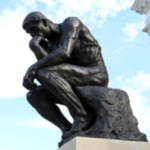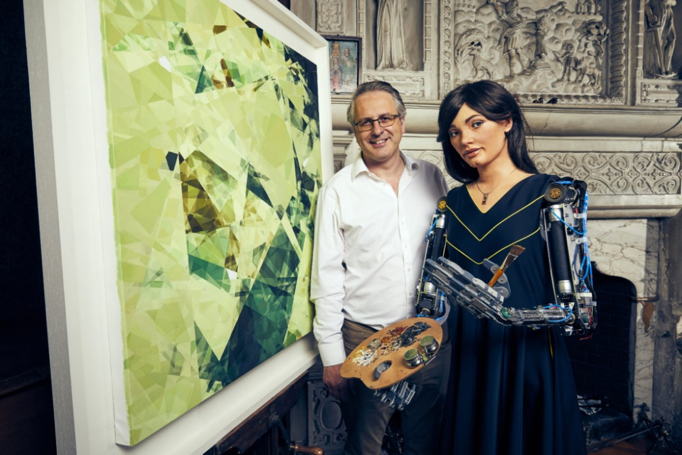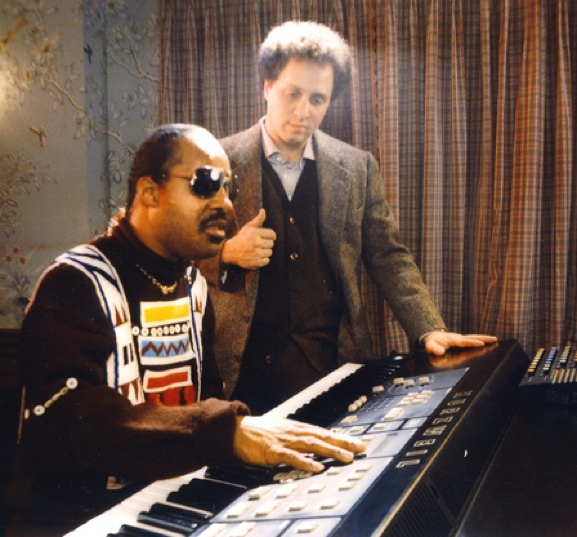Jun 21, 2021 | Neurobioethics
POSTER | FLYER
THE PROJECT AND ITS GOALS
The Neurobioethics Interdisciplinary Research Group (GdN) at the Athenaeum Pontificium Regina Apostolorum (APRA) of Rome, inspired by the recent achievements made in the field of neurotechnologies, will dedicate its reflection, research, publication and formation of the year 2021-2022 to the critical analysis of the emerging scenarios relating to the progressive human-technology hybridization: from the developments of electroencephalography to those of magnetic resonance, from the braincomputer- robot interfaces up to the “reading of mind” and the so-called “cybernetic telepathy”. These solicitations of robotics, of the development of artificial intelligence, of the multiple applications of human enhancement, challenge the man and woman of today called to know in order to decide with awareness the direction to be given to neuro-technological progress.
This fifth Training Course in neurobioethics “Neurobioethics and Neurotechnologies” will collect the fruit of the interdisciplinary reflection of the GdN. The course will be offered in Italian and English and will be broadcast online in streaming for those who register.
After a ten-year research experience, the GdN will offer from September 2021 to June 2022, a package
of 10 seminars and the March conference within the Brain Awareness Week promoted by the DANA
Foundation, on technological, neurological, neurosurgical, psychiatric, psychological, philosophical, ethical,
bioethical, legal and theological aspects related to the progressive hybridization of technology to human corporeality through more or less invasive systems of neural interface. The main purpose is to become aware of the anthropological, ethical, legal, health and social consequences and consequences of these uses and interventions for the life of the human being.
Particular emphasis will be given to the consideration of the issues related to the principles enshrined in the UNESCO Bioethics and Human Rights Declaration of 2005. This sensitivity will touch specifically on
issues relating to the limit, dignity, identity and value of the human body.
COURSE STRUCTURE
The course includes a two-hour monthly meeting (seminar or round table) starting on Friday
24/09/2021 until Friday 24/06/2022. The dates and times of the meetings are the following:
• 24/09/2021, 17-19:00
• 29/10/2021, 17-19:00
• 26/11/2021, 17-19:00
• 17/12/2021, 17-19:00
• 21/01/2022, 17-19:00
• 25/02/2022, 17-19:00
• 18/03/2022, Brain Awareness Week 2022, 15-19:00
• 29/04/2022, 17-19:00
• 20/05/2022, 17-19:00
• 24/06/2022, 17-19:00
The specific contents and speakers will be communicated month by month and will progress from the technological, neurological, neurosurgical, psychiatric, psychological, philosophical, ethical, bioethical, legal and theological aspects related to the progressive hybridization of technology to human corporeality through more or less invasive systems of neural interface.
TARGET
This training course is created for all of those who wish to become more aware of the development, application to humans and the environment of “artificial intelligence”; specifically: politicians, bioethicists, engineers, teachers, trainers, doctors, philosophers and theologians. At the end of the course a certificate will be issued to the attendees, and after the evaluation of their summary of the course, 3 ECTS credits will be issued.
SIGNING UP
The registration fee and the total course fee is € 400
Registration deadline: 27/09/2021: € 50 of discount
Registration deadline: 31/10/2021
Coordinator of the specialization course:
Prof. P. Alberto Carrara, L.C.
FOR FURTHER INFORMATION
Email: info.bioetica@upra.org
Tel.: +39 06 91689848 – Cell.: +39 345 1066853
PROMOTERS
School of Bioethics
Neurobioethics Study Group
Institute of Science and Faith
May 4, 2020 | Neurobioethics, Neuroscience, News
By Claudia Fini, Chair intern
The Neurobioethics Group of the Regina Apostolorum Pontifical University (UNESCO Chair in Bioethics and Human Rights and the Science and Faith Institute) and the BrainCircle Italia presented the digital meeting entitled ‘The epidemic at the time of Artificial Intelligence’, a day of reflection born from the urgent need to develop, in relation to the contingent situation, a series of reflections on the possibility of using artificial intelligence and technology to combat the Covid-19 pandemic.
The SARS-CoV-2 (Coronavirus) epidemic, which has spread in Italy in recent months, has sadly resulted in a large number of deaths officially certified as positive for the virus. In China, the final study of the World Health Organization has recorded 3,259 deaths with a mortality rate of 3.8%. The same mortality in Italy has been shown to have increased to 9% with a peak of 12.1% in Lombardy.
The factors that contribute to the calculation of such data are many. It must be considered that in Italy, the mortality rate is higher due to the presence of an older population and the lack of testing for milder cases which are solely isolated. The development and distribution of official statistical knowledge is therefore of clear importance in measuring the performance of the economy and the community.
![]()
In light of this emergency, the National Institute of Statistics Istat has activated a series of actions aimed at ensuring the continuity and quality of statistical production, directing the collection of statistical data on sustainable acquisition techniques with methodological solutions and innovations for the use of data sources in full protection of workers’ health.
Mortality information is an essential element in defining the dynamics of the current pandemic in relation to past events. In his speech, the president of Istat Giancarlo Blangiardo illustrates how, through time, the mortality trend in Italy has been characterized by a series of peaks among which the first appears in 1918, followed by other peaks in 1956, 2015 and 2019.
The current rise in mortality due to the Covid-19 epidemic recalls, at least in the tones that emphasize the socio-health system, the global pandemic known as the “Spanish flu” which, in Italy, manifested its most devastating effect in 1918. Despite the apparent similarity, the comparison between the two pandemics must be carried out carefully. Not only has there been an extraordinary technological leap and medical and health knowledge gap between the present and 1918, but we have also to consider that the post-war years represented a particularly difficult period at a global level, with a population weakened from the end of the war. All this is present in a 1925 essay by Giorgio Mortara that concludes that the “Spanish” pandemic brought about 600,000 deaths.
Covid-19 dramatically affected the elderly component of the population in a similar way to past events that occurred in 1956 and 2015. In 1956, an influenza element, accompanied by record winter minimum temperatures, caused an increase in mortality of around 50,000 deaths compared to the previous year. Similarly, in 2015, mortality saw an equal increase of 50,000 deaths, especially among the elderly, caused by a particularly harsh winter associated with a hot summer, as well as by the refusal to vaccinate by a large percentage of the elderly population.
By observing past mortality peaks, Istat has identified possible changes with respect to the aging process and the seniority rate. According to a first scenario, a 29% increase in mortality is assumed consistently for a period of three months. This first option is relatively favourable and reflects the changes in the risk of death of people over the age of 60 in correspondence with the rise in mortality of 1956. This scenario proposes a relatively limited number of deaths, a slowdown in life expectancy without however changing the aging of the population which will increase moderately. A decidedly more pessimistic alternative is to assume a 63% increase in the probability of death for the population over the age of 65, on a constant basis for a quarterly duration. This increase corresponds to what has been calculated by comparing the probability of death in 1918, the year “disturbed” by the “Spanish” epidemic. A third scenario, perhaps more realistic, and in any case closer to the current reality, consists in starting from a 44% increase in mortality for individuals over the age of 65 observed in March 2020 compared to the same period in 2019. This phenomenon would however, progressively diminish over time, ultimately returning to typical values. The fourth and last scenario resumes the previous model assuming an equal increase in mortality of 44% for two months (March-April) followed by + 22% for May-June and finally 11% for the quarter from July to September. As a variant of the previous scenario, the optimistic approach could be reduced by assuming a more advanced progression of the adverse effects of the pandemic.
May 4, 2020 | Neurobioethics, Neuroscience, News
By Prof. Fr. Alberto Carrara, LC, Chair Fellow
The mysterious American writer Emily Elisabeth Dickinson (1830-1886) is mostly known for her unusual life, spent mainly reclused in her house in Amherst, where she was born. Her work, in addition to her well-known poetry on the brain “The Brain is wider than the Sky”, has one poem dedicated to the storm.
Translated by Eugenio Montale in 1945, this poem, number 1593, reads:
There came a wind like a bugle;
It quivered through the grass,
And a green chill upon the heat
So ominous did pass
We barred the windows and the doors
As from an emerald ghost;
The doom’s electric moccason
That very instant passed.
On a strange mob of panting trees,
And fences fled away,
And rivers where the houses ran
The living looked that day.
The bell within the steeple wild
The flying tidings whirled.
How much can come
And much can go,
And yet abide the world!
The world learned about the Coronavirus on January 12th, 2020 when the World Health Organization (WHO) recognised it as “2019-nCoV” (i.e. new Coronavirus 2019) and its related pathology “COVID-19”. The Coronavirus has spread globally as a “storm” striking a globalized and technologized world that moved frantically and almost unstoppably towards the achievement of its growth, production and efficiency objectives, rewarding with fame the typical “hard” and “soft skills” of our industries 4.0.
For months, silence, isolation, the desert of our cities, the solitude of our monuments have become our existential “storm”.
In an evocative, though eerily empty Piazza San Pietro, on March 27th, Pope Francis described this tragic moment with these words:
“Dense darkness has thickened on our squares, streets and cities; it has taken over our lives filling everything with a deafening silence and a desolate void, which paralyzes everything in its passing: you can feel it in the air, you can feel it in people’s gestures and looks. We found ourselves afraid and lost”.
As the Israeli historian Yuval Noah Harari recently pointed out, on the one hand, we are living in the best time to be able to clinically and technologically face this pandemic thanks to the development of molecular medicine, biotechnology and artificial intelligence. On the other hand, the coronavirus storm is exposing our vulnerabilities, leaving uncovered those superfluous certainties with which we have built our agendas, our projects, our habits and priorities.
SARS-Cov-2 (the new Coronavirus) has no boundaries, is not subject to barriers, nor walls, affects everyone, does not look at anyone, does not consider passports, social class and does not read the titles on our business cards. But the same reason why it spreads — our common human nature — makes us rediscover the common antidote: we are not monads closed in on ourselves, but we are all united and intrinsically connected to each other as no one can survive on their own. The Coronavirus should awake us from the deafening frenzy to which we were accustomed, and which now frightens us for its unrecognizable silence. The pandemic that struck us underlines how we are all deeply in communion with each other through the multiple interactions that connect us, so today more than ever we feel the thrill of the common bond to which we cannot escape: to belong as brothers. None of us lives alone, others’ lives are always present in mine in what I think, say, do, work. And vice versa, my life enters that of others.
“We have realized that we are on the same boat, all of us fragile and disoriented, but at the same time important and needed, all of us called to row together, each of us in need of comforting the other. On this boat… are all of us. Just like those disciples, who spoke anxiously with one voice, saying “We are perishing” (v. 38), so we too have realized that we cannot go on thinking of ourselves, but only together can we do this.”
(Pope Francis, 27th March 2020).
On the horizon, we may face a significant, longer-term problem concerning the issue of surveillance and individual control through biometric recognition that states could maintain and implement even after the epidemic crisis. Harari warns us: “one of the dangers of the current epidemic is that it will justify extreme control measures … But even after it, this idea will remain”.
We are called to reinvent our relationships and to discover our deep skills, those relating to our empathic ability, to know how to be with others, to listen, to be in solidarity, but also to be morally sound and responsible.
To reflect on this existential situation we are experiencing, the Neurobioethics Group and Brain Circle Italia organized a day dedicated to the topic “The epidemic at the time of artificial intelligence. A new anthropology for a safer world?” which took place on 23rd April 2020 live from the Neuroscience and Neuroethics Facebook page.
A panel of the highest scientific and cultural depth divided into 5 sessions debated today’s epidemic contingency in an interdisciplinary discussion. Over 5,000 people followed the event.
The digital revolution has the potential to become a new form of coexistence among people who, in their fight against the new enemy presented by epidemics, prompt us to reconsider the concepts of privacy and freedom. The need then emerges for a pact between citizens and institutions to rethink the methods of application of what Hobbes would call a new “law of nature”. But how much of our identity spaces are we willing to give up to fight these invisible threats?
Prof. Claudio Bonito presented and moderated the event. After the greetings from the academic authorities, Viviana Kasam, President of BrainCircleItalia and Father Alberto Carrara, Director of the Neurobioethics Group introduced the topic at hand.
The morning (10:30-12:30) was divided in a first scientific portion with the presentations of:
Gian Carlo Blangiardo, President of ISTAT
Luca Maria Gambardella, University of Lugano, Dalle Molle Institute of Studies on Artificial Intelligence USI-SUPSI.
In the second medical-clinical portion of the conference spoke:
Matilde Leonardi, neurologist, pediatrician, Director of UOC – IRCCS Foundation Neurological Institute Carlo Besta, Milan;
Nicolino Ambrosino, pulmonologist – Maugeri Scientific Clinical Institutes
Stefano Mazzoleni, professor of Computer Science and Big Data Analytics – Bari Polytechnic.
The afternoon (15:30-18:30) opened with the legal session, with the following speakers:
Amedeo Santosuosso, scientific director, European Center for Law, Science and New Technologies (ECLT), University of Pavia;
Avv. Tania Cerasella, lawyer, member of the GdN
Avv. Emanuela Cerasella, lawyer, Coordinator of the Neurolaw subgroup of the GdN.
The technical-analytical-philosophical session followed with the presentation of:
Damiano Sabatino, CEO Travelport and Guido Traversa, philosopher, European University of Rome – Master Coordinator in Philosophical Consultancy and Existential Anthropology.
The conference Concluded with the psychiatric session in which the following speakers are present: Donatella Marazziti, psychiatrist, University of Pisa, Professor at the Unicamillus University of Rome, Head of research BRF Brain Research Onlus Foundation
Armando Piccinni, neurologist and psychiatrist, Professor at Unicamillus University of Rome, President of BRF Brain Research Onlus Foundation.




